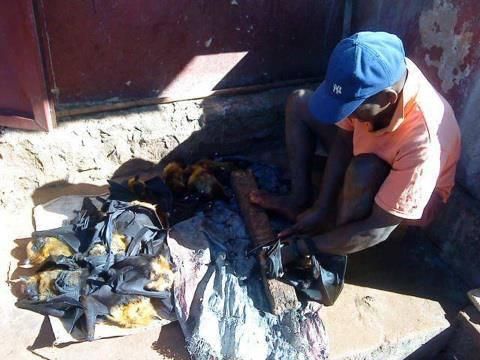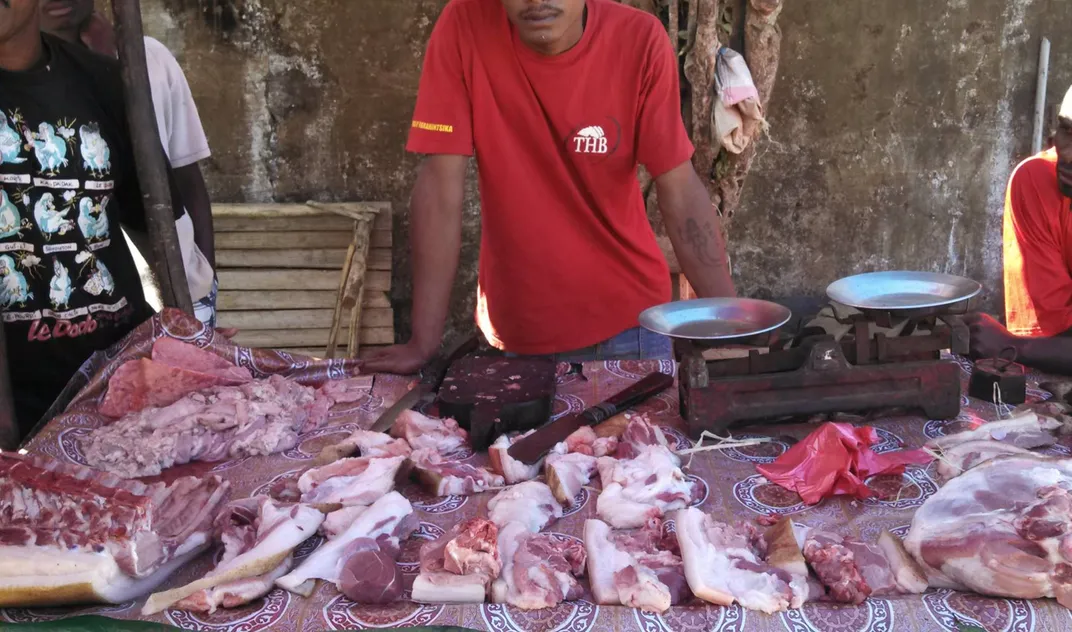Why People Turn to Lemurs and Other Endangered Animals for Dinner in Madagascar
A close look at trade in bushmeat finds that consumption is common and out in the open
/https://tf-cmsv2-smithsonianmag-media.s3.amazonaws.com/filer/1c/f3/1cf3981d-3933-4cae-a88e-02fb648acc9c/corbis-42-33052979.jpg)
Madagascar is home to many unique and threatened mammals, such as lemurs and small hedgehog-like creatures called tenrecs. Most people wouldn’t think of consuming one of these animals, but for many in Madagascar, bushmeat is on the menu. Scientists assumed that people turned to wild meat just to survive, but two new studies that examine the entire supply chain for this meat have found that consumption of wild mammals in Madagascar is common and far more open a practice than anyone had suspected.
“One of the issues that’s maybe stymied progress [in thwarting the bushmeat trade] is that it always felt like there was a fight between: Are they people starving? Or are they just rich and they want to eat bushmeat as a luxury good?” says the studies’ lead author Kim Reuter, a biologist previously of Temple University and now at Conservation International in Nairobi. “But I want people to see that the reality is less homogenous, in that these are normal people” eating these animals.
In many cases, ordinary people are buying wild meat when they have some extra money, and the commercial part of the bushmeat trade is out in the open and easy to find, Reuter and her colleagues report in PLOS One and an upcoming paper in Environmental Conservation.

Reuter and her colleagues interviewed people in cities and rural towns across northern Madagascar, including in the capital, Antananarivo, in May through August 2013. At every fifth house, the scientists knocked and asked the head of the household about their meat preferences and meat consumption during the last three days, as well as over their lifetime.
The study area covered a cross-section of northern Madagascar, ranging from urban to rural and including many ethnic and religious groups. Some 83 percent of those surveyed said they held taboos against eating certain kinds of meat. These taboos varied by religion, tribe, family and region. Muslims, for example, are not supposed to eat any forest animals, including bushmeat. And families often have taboos against eating specific animals, such as lemurs or tenrecs, which some believe to be associated with bad agricultural harvests.
Reuter’s team heard other reasons for avoiding bushmeat, as well. “We're in this village in the middle of nowhere,” she recalls, “and this old guy would just tell us, ‘Oh, I don’t eat any lemurs anymore. It’s bad for my cholesterol.’”
Still, 78 percent of people surveyed had eaten wild meat in their lifetimes, and 31 percent had eaten it in the previous six to eight months.
Those surveyed gave different reasons for eating different mammals. For example, they often ate carnivores like the cat-like fossa because the animals ate human food or were threatening farm animals. Lemurs and tenrecs tended to be consumed for subsistence, in contrast, and bats and wild pig were eaten when people had income to spend.
A smaller study, from 2014, had estimated that 98 percent of wild meat in Madagascar was obtained informally, through hunting, bartering or gifting. But Reuter’s team found that in rural areas, about 30 percent of the bat and lemur meat was purchased. And urban residents, their survey showed, purchased 56 percent of the bat meat they ate and 62 percent of their wild pig meat in markets or restaurants. The commercial trade in urban areas was concentrated in a few well-known market stalls and restaurants. Reuter also saw packaged, frozen wild pig available in some supermarkets.

These markets and restaurants were not hard to find. “Once we started asking,” says Reuter, “everyone was like, ‘Of course, that place down the street, didn’t you know?’” She had even eaten at one restaurant without noticing that bushmeat was on the menu.
“This type of comprehensive study is really important,” says Drew Cronin, a conservation biologist at Drexel University who studies the bushmeat market in Equatorial Guinea in Africa. “It's hard to target conservation planning unless you've been out there and have the on-the-ground knowledge.”
This new trove of information about wild meat eating suggests that better enforcement of the law help to conserve the rare fauna of Madagascar, says Reuter. Hunting is currently limited by law, but she says none of the hunters she met had a permit to hunt because rules are overly complex and not well-communicated. Outlawing all hunting wouldn’t be a great option, however, because some people do need bushmeat to survive, she says. Conservation efforts might be better spent on targeting the commercial trade in bushmeat at markets and restaurants.
In addition, says Cronin, “Education and outreach is pretty much always positive. The only drawback is, it's a long game.”
During her research, Reuter also noticed that some bat, wild pig and tenrec meat was priced high enough that it’s probably aimed at the tourist market. She suggests educating tourists and adopting a voluntary labeling scheme for meat that has been obtained legally, such as from wild pigs that threatened livestock.
“I believe that if we don’t act on this now,” she says, “it doesn’t matter what research we do. There won’t be much bushmeat left in 10 years to study.”